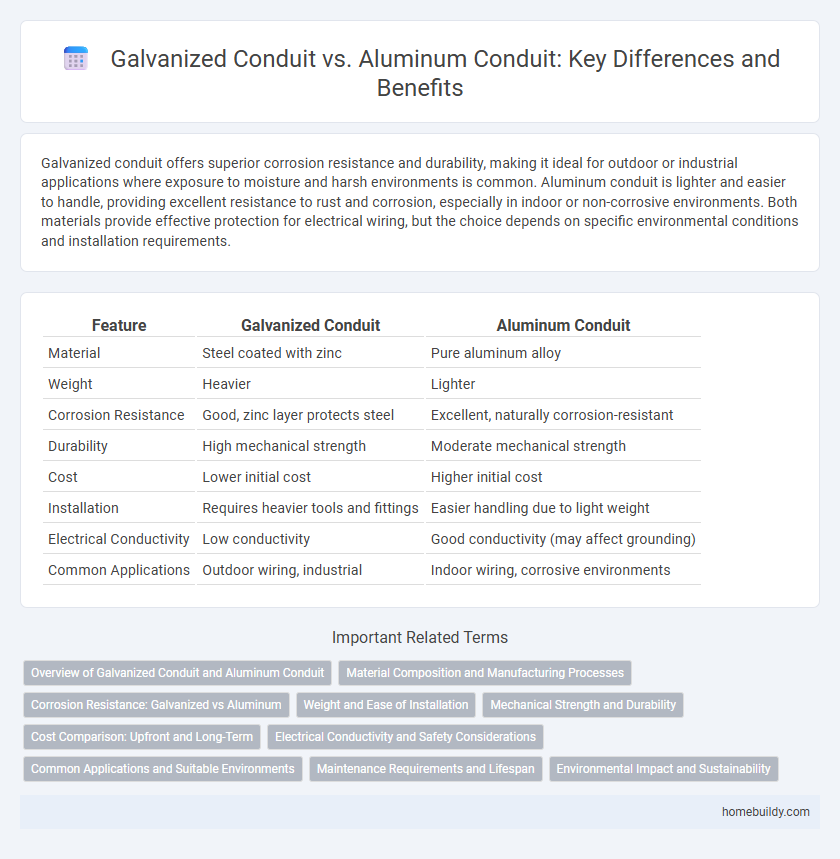Galvanized conduit offers superior corrosion resistance and durability, making it ideal for outdoor or industrial applications where exposure to moisture and harsh environments is common. Aluminum conduit is lighter and easier to handle, providing excellent resistance to rust and corrosion, especially in indoor or non-corrosive environments. Both materials provide effective protection for electrical wiring, but the choice depends on specific environmental conditions and installation requirements.
Table of Comparison
| Feature | Galvanized Conduit | Aluminum Conduit |
|---|---|---|
| Material | Steel coated with zinc | Pure aluminum alloy |
| Weight | Heavier | Lighter |
| Corrosion Resistance | Good, zinc layer protects steel | Excellent, naturally corrosion-resistant |
| Durability | High mechanical strength | Moderate mechanical strength |
| Cost | Lower initial cost | Higher initial cost |
| Installation | Requires heavier tools and fittings | Easier handling due to light weight |
| Electrical Conductivity | Low conductivity | Good conductivity (may affect grounding) |
| Common Applications | Outdoor wiring, industrial | Indoor wiring, corrosive environments |
Overview of Galvanized Conduit and Aluminum Conduit
Galvanized conduit, made from steel coated with a layer of zinc, offers superior corrosion resistance and mechanical durability, making it suitable for outdoor and industrial electrical installations. Aluminum conduit is lightweight, highly resistant to corrosion, and easier to install, commonly used in commercial and residential wiring where flexibility and reduced weight are priorities. Both conduits protect electrical wiring but differ mainly in weight, corrosion resistance, and cost, influencing their specific applications in electrical systems.
Material Composition and Manufacturing Processes
Galvanized conduit is made from steel coated with a layer of zinc to enhance corrosion resistance through a hot-dip galvanization process, providing durability and strength in harsh environments. Aluminum conduit consists primarily of lightweight aluminum alloy, manufactured via extrusion or drawing processes that offer flexibility and excellent resistance to corrosion without requiring additional coatings. The distinct material compositions and manufacturing methods influence their suitability for different electrical installation applications, with galvanized steel favored for mechanical toughness and aluminum preferred for lightweight, corrosion-prone settings.
Corrosion Resistance: Galvanized vs Aluminum
Galvanized conduit features a zinc coating that provides strong protection against rust, especially in outdoor or moist environments, making it ideal for heavy-duty applications. Aluminum conduit offers superior corrosion resistance in marine or highly corrosive environments due to its natural oxide layer, which prevents further oxidation. When selecting between galvanized and aluminum conduit, factors such as exposure to saltwater, humidity levels, and lifespan requirements heavily influence the optimal choice.
Weight and Ease of Installation
Galvanized conduit is heavier than aluminum conduit, which affects handling and transportation during installation. Aluminum conduit's lighter weight significantly reduces labor effort and time, making it easier to install, especially in overhead or long-run applications. The corrosion resistance of aluminum also minimizes the need for extra protective coatings, further streamlining the installation process.
Mechanical Strength and Durability
Galvanized conduit offers superior mechanical strength and enhanced corrosion resistance due to its steel composition with a protective zinc coating, making it ideal for high-impact environments. Aluminum conduit provides excellent corrosion resistance and lightweight advantages but has lower mechanical strength compared to galvanized conduit, limiting its use in heavy-duty applications. Choosing between galvanized and aluminum conduit depends on balancing the need for durability and impact resistance against weight and environmental factors.
Cost Comparison: Upfront and Long-Term
Galvanized conduit typically has a higher upfront cost due to the steel material and protective zinc coating, but offers superior durability and corrosion resistance, reducing maintenance expenses over time. Aluminum conduit is generally less expensive initially and lighter, easing installation and lowering labor costs, though it may incur higher long-term costs in harsh environments due to increased susceptibility to corrosion and damage. Evaluating total cost of ownership involves balancing initial purchase price against longevity, environmental factors, and maintenance requirements specific to the installation setting.
Electrical Conductivity and Safety Considerations
Galvanized conduit, coated with zinc to prevent corrosion, offers moderate electrical conductivity suitable for grounding applications but may introduce slight resistance compared to aluminum conduit. Aluminum conduit features higher electrical conductivity, enhancing current flow efficiency and reducing energy loss in electrical systems. Safety considerations prioritize the non-corrosive properties of galvanized conduit for harsh environments, while aluminum conduit requires careful handling to avoid damage and ensure proper grounding to prevent electrical hazards.
Common Applications and Suitable Environments
Galvanized conduit, known for its robust corrosion resistance, is commonly used in outdoor and industrial environments where exposure to moisture and harsh conditions is frequent. Aluminum conduit, favored for its lightweight properties and excellent corrosion resistance, is suitable for indoor applications, commercial buildings, and areas with less mechanical stress. Both conduits serve critical roles in electrical wiring protection but are chosen based on environmental factors and specific project requirements.
Maintenance Requirements and Lifespan
Galvanized conduit offers superior corrosion resistance with a zinc coating that requires minimal maintenance, making it ideal for outdoor or damp environments, and typically lasts between 30 to 50 years. Aluminum conduit is lightweight and corrosion-resistant but may need more frequent inspections and cleaning to prevent oxidation, with an average lifespan of 20 to 40 years. Choosing between them depends on balancing maintenance frequency and expected service life based on environmental conditions.
Environmental Impact and Sustainability
Galvanized conduit, made from steel coated with zinc, offers robust corrosion resistance but involves energy-intensive manufacturing and significant carbon emissions due to steel production. Aluminum conduit provides a lighter, corrosion-resistant alternative with a lower carbon footprint and higher recyclability, contributing to reduced environmental impact. Choosing aluminum conduits supports sustainability goals by minimizing resource consumption and enhancing material reuse in electrical installations.
Galvanized conduit vs Aluminum conduit Infographic

 homebuildy.com
homebuildy.com